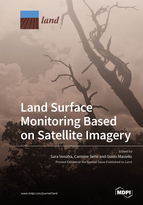Land Surface Monitoring Based on Satellite Imagery
A special issue of Land (ISSN 2073-445X). This special issue belongs to the section "Land Systems and Global Change".
Deadline for manuscript submissions: closed (30 September 2022) | Viewed by 47669
Special Issue Editors
Interests: satellite remote sensing; land surface change detection; retrieval of surface and atmospheric parameters; climate; radiative transfer; air quality; global warming and change
Special Issues, Collections and Topics in MDPI journals
Interests: satellite remote sensing of surface and atmospheric parameters; land surface change detection; radiative transfer in cloudy and clear atmosphere; Fourier spectroscopy applied to remote sensing of atmosphere; satellite instruments characterization; climate; global warming and change; inverse problems and dimensionality reduction of data space; satellite retrieval of atmospheric constituents and aerosols; greenhouse gases; air quality
Special Issues, Collections and Topics in MDPI journals
Interests: satellite remote sensing of surface and atmospheric parameters; land surface change detection; radiative transfer in cloudy and clear atmosphere; Fourier spectroscopy applied to remote sensing of atmosphere; satellite instruments characterization; climate; global warming and change; inverse problems and dimensionality reduction of data space; satellite retrieval of atmospheric constituents and aerosols; greenhouse gases; air quality
Special Issues, Collections and Topics in MDPI journals
Special Issue Information
Dear Colleagues,
Land surface monitoring plays a significant role in the study of climate change and global warming. Even though in situ measurements represent the most accurate way to measure surface parameters, they lack in spatial and temporal resolution. For this purpose, satellite data provide a global coverage and higher temporal resolution with very accurate retrievals of land parameters such as surface temperature and emissivity. Land surface parameters from remote sensing are incredibly attractive for applications in different environmental fields, such as land use/change, monitoring of vegetation and soil water stress, and early warning and detection of forest fires and drought. Typically, monitoring of land cover changes is based on the definition of vegetation indices, exploiting the surface information provided by the spectral channels in the visible and the infrared.
We invite researchers and academics to submit papers that deal but are not limited to the previous topics.
Dr. Sara Venafra
Prof. Dr. Carmine Serio
Prof. Dr. Guido Masiello
Guest Editors
Manuscript Submission Information
Manuscripts should be submitted online at www.mdpi.com by registering and logging in to this website. Once you are registered, click here to go to the submission form. Manuscripts can be submitted until the deadline. All submissions that pass pre-check are peer-reviewed. Accepted papers will be published continuously in the journal (as soon as accepted) and will be listed together on the special issue website. Research articles, review articles as well as short communications are invited. For planned papers, a title and short abstract (about 100 words) can be sent to the Editorial Office for announcement on this website.
Submitted manuscripts should not have been published previously, nor be under consideration for publication elsewhere (except conference proceedings papers). All manuscripts are thoroughly refereed through a single-blind peer-review process. A guide for authors and other relevant information for submission of manuscripts is available on the Instructions for Authors page. Land is an international peer-reviewed open access monthly journal published by MDPI.
Please visit the Instructions for Authors page before submitting a manuscript. The Article Processing Charge (APC) for publication in this open access journal is 2600 CHF (Swiss Francs). Submitted papers should be well formatted and use good English. Authors may use MDPI's English editing service prior to publication or during author revisions.
Keywords
- satellite remote sensing
- land surface parameters
- surface change detection
- radiative transfer
- infrared spectroscopy
- global warming
- climate
- vegetation Indices
Related Special Issue
- Land Surface Monitoring Based on Satellite Imagery II in Land (3 articles)








